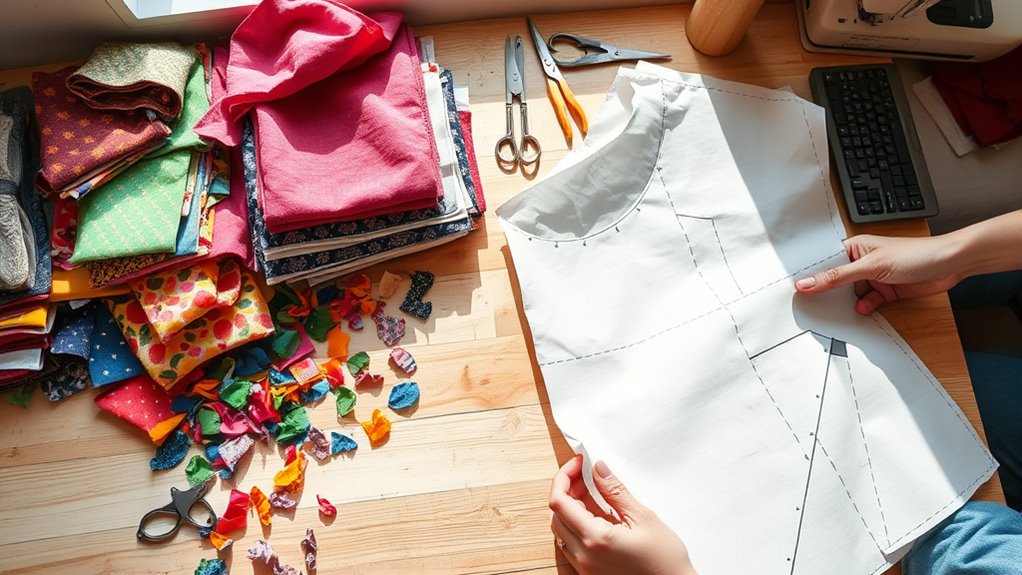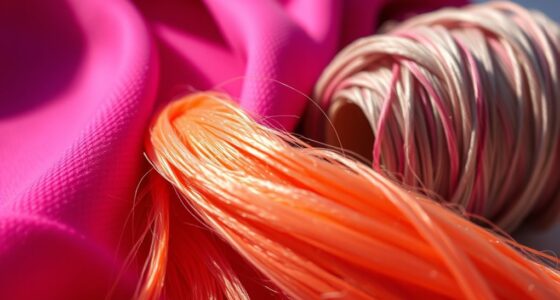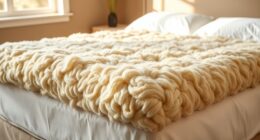Zero-waste pattern-making can slash fabric waste by up to 80% because it encourages you to design puzzle-like patterns that maximize fabric use and eliminate leftovers. By planning your pieces carefully and thinking creatively about fabric placement, you reduce scraps and waste considerably. This sustainable approach not only saves money but also shows your commitment to eco-friendly practices. Keep exploring how innovative design strategies can transform your production process even further.
Key Takeaways
- Zero-waste pattern-making designs puzzle-like patterns that maximize fabric use and eliminate scraps during cutting.
- Precise planning and innovative pattern arrangements reduce fabric waste by up to 80%.
- Efficient fabric utilization minimizes disposal costs and environmental impact for fashion businesses.
- Combining zero-waste techniques with eco-friendly dyes enhances sustainability and brand reputation.
- Implementing these methods supports circular economy principles, promoting responsible production and waste reduction.

Have you ever wondered if it’s possible to create clothing patterns without waste? With zero-waste pattern-making, you can transform your approach to fashion design by substantially reducing fabric scraps. This method involves designing patterns that fit together like puzzle pieces, minimizing leftover material after cutting. When you adopt this technique, you’re not just saving fabric—you’re also making a conscious choice to support sustainable sourcing. By selecting fabrics from suppliers committed to eco-friendly practices, you ensure that your entire process aligns with environmentally responsible principles. Sourcing from brands that prioritize sustainable materials reduces harm to ecosystems and promotes a circular economy, making your collection more eco-conscious from start to finish.
Zero-waste pattern-making supports sustainable sourcing and minimizes fabric waste for eco-conscious fashion design.
As you explore zero-waste techniques, you’ll find that incorporating eco-friendly dyes into your design process amplifies your positive impact. Traditional dyeing methods can be resource-intensive, consuming large amounts of water and creating chemical waste. Eco-friendly dyes, on the other hand, are derived from natural sources like plants, minerals, or recycled materials, which markedly lessen environmental harm. Using these dyes not only results in vibrant, durable colors but also aligns with your goal of reducing the ecological footprint of your fashion production. When you combine zero-waste pattern-making with eco-friendly dyes, you’re crafting garments that are as kind to the planet as they are stylish.
Furthermore, this approach encourages innovation in pattern design. Instead of following conventional templates, you learn to think creatively about how fabric pieces can fit together efficiently. You’ll discover that meticulous planning and a keen eye for detail allow you to cut patterns in a way that maximizes fabric use, leaving little to no waste. This process challenges the traditional mindset of excessive fabric leftovers and pushes you toward more sustainable manufacturing practices. It demands patience and precision, but the payoff is substantial—a dramatic reduction in fabric trash, often by as much as 80 percent. Incorporating mindful design principles helps you develop more efficient patterns that optimize fabric use and reduce waste.
Ultimately, zero-waste pattern-making empowers you to take control of your environmental impact. It’s a practical method that benefits your business by reducing costs associated with fabric waste and waste disposal. More importantly, it aligns your brand with the growing consumer demand for sustainable fashion. By prioritizing sustainable sourcing and eco-friendly dyes, you’re demonstrating a commitment to a greener future. This isn’t just about creating beautiful garments; it’s about redefining how fashion can be produced responsibly, with less waste and more respect for our planet.
Frequently Asked Questions
How Does Zero-Waste Pattern-Making Impact Overall Garment Durability?
Zero-waste pattern-making positively impacts garment durability by enhancing fabric longevity and seam integrity. When you design with minimal waste, you use fabric more efficiently, reducing stress on seams and preventing weak points. This meticulous approach results in stronger, longer-lasting garments that resist wear and tear. By prioritizing precise pattern placement, you guarantee your clothing maintains its quality over time, offering durability without sacrificing style or sustainability.
Can Zero-Waste Techniques Be Adapted for Mass Production?
Imagine a factory floor where zero-waste techniques seamlessly blend with mass production scalability. You can adapt zero-waste pattern-making to large runs, but it requires careful planning and innovative machinery. While some consumers embrace eco-friendly practices, others may resist changes in design or cost. You must balance sustainability with consumer acceptance, ensuring zero-waste methods are efficient enough for mass production without sacrificing quality or market appeal.
What Training Is Needed to Implement Zero-Waste Pattern-Making?
To implement zero-waste pattern-making, you need training in pattern drafting and sewing techniques. You should learn how to creatively design patterns that maximize fabric usage, reducing waste. Understanding seam allowances, fabric grain, and layout planning helps you create efficient, waste-free patterns. Practice these skills through workshops or courses, and stay updated on innovative methods. This knowledge empowers you to produce sustainable, zero-waste designs confidently.
Are There Specific Fabric Types Best Suited for Zero-Waste Methods?
You should focus on fabric types that have minimal stretch and dye compatibility, making zero-waste pattern-making easier. Natural fabrics like linen and cotton work well because they don’t stretch much and dye consistently, reducing waste. Stretch fabrics can be tricky, but if you choose materials with limited stretch, you’ll find it easier to create patterns with zero waste. Always test dye compatibility to avoid unnecessary fabric discard.
How Does Zero-Waste Pattern-Making Affect Design Creativity?
You might think zero-waste pattern-making stifles creativity, but it actually sparks innovative thinking. By working within strict fabric constraints, you push your artistic experimentation and embrace sustainable innovation. This approach challenges you to design smarter, not harder, turning limitations into opportunities for unique, thoughtful creations. It’s a fresh perspective that encourages you to explore new shapes, textures, and styles—proving that less waste can lead to more inspired design.
Conclusion
By adopting zero-waste pattern-making, you’re not just cutting fabric scraps—you’re shaping a future where waste no longer defines us. Each pattern you create becomes a seed of change, symbolizing hope and responsibility. As you embrace this method, imagine planting a forest of sustainable habits that grow stronger with every garment. Together, you can transform trash into treasure, forging a path toward a cleaner, more mindful world where your choices echo beyond the fabric.










